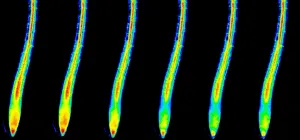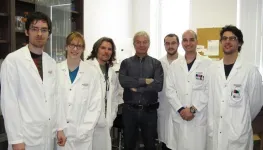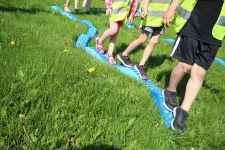Researchers show where and how plants detect the nutrient potassium
Newly discovered group of cells in the root tip reacts to potassium deficiency and directs signalling pathways mediating plant adaptation
2021-03-23
(Press-News.org) Potassium is an essential nutrient for all living things. Plants need it in large quantities, especially for growth and in order to withstand stress better. For this reason, they absorb large quantities of potassium from the soil. In agriculture, this leads to a lack of available potassium in the soil - which is why the mineral is an important component in fertilizers. A team of German and Chinese researchers has now shown, for the first time, where and how plants detect potassium deficiency in their roots, and which signalling pathways coordinate the adaptation of root growth and potassium absorption to to uphold the plants potassium supply.
The background: The absorption and transportation of potassium at the level of individual cells have been relatively well characterized, and many of the molecular structures and mechanisms which play a role in these processes are known. Also, researchers demonstrated decades ago that plants adapt very specifically to potassium deficiency. One puzzle that still remains, however, is how plants detect the availability of potassium in the soil and which mechanisms are behind the adaptational reactions in the plant's organism. The new study sheds light on these questions. The results have been published in the journal Developmental Cell
Observations contradict the textbooks
The researchers examined thale cress plants (Arabidopsis thaliana) which were transformed with the newly developed potassium reporter protein GEPII. This reporter protein enables the microscopic detection of the concentration and distribution of potassium ions in cells and tissues. Even when there was no potassium deficiency, the research team made a very surprising discovery: the concentration of this nutrient in the cytoplasm of the cells increased with each cell layer within the root, from the outside to the inside.
"These observations were really surprising," says Prof. Jörg Kudla from the Institute of Plant Biology and Biotechnology at the University of Münster (Germany). "They contradict the textbooks, which say that the nutrients are passed on evenly, from the outside to the inside, towards the root's vascular tissue - not only from cell to cell but also through the intercellular spaces."
"Potassium-sensitive niche" reacts to potassium deficiency
The team of researchers subsequently examined how roots react to potassium deficiency. In doing so, they demonstrated for the first time that if plants are subjected to potassium deficiency, the concentration of potassium is reduced only within certain cells in the root tip. These "postmeristematic cells" directly above the viable stem cells in the root tip react extremely rapidly to potassium deficiency; the concentration of potassium inside the cell (in the cytoplasm) decreases within seconds. It had not previously been known that a certain group of cells located centrally inside the root tip reacts to a potassium deficiency in its surroundings. The researchers named this group of cells "potassium-sensitive niche".
"These observations, too, were very surprising," says Kudla. "If plants are deprived of potassium, only the cells in the potassium-sensitive niche show a reaction; the concentration of potassium in the other root cells remains unchanged. Previously it was assumed that naturally the cells in the outermost cell layer, the epidermis, would react first to a reduction in the concentration of potassium in the soil."
Visualizing the path of potassium
Simultaneously with the decrease in the potassium concentration in the potassium-sensitive niche, calcium signals occur in these cells and spread out in the root. As a messenger substance, calcium controls many processes in living organisms - just as it does here: the calcium signals start off a complex molecular signalling cascade. This chain of signals, which the researchers were the first to define in detail, ultimately causes not only an increased formation of potassium transport proteins, but also brings about changes in tissue differentiation in the root. This facilitates a more efficient absorption of potassium ions and maintains its distribution in the plant. "For the first time," says Kudla, "using imaging methods, we have visualized the path of potassium in a living organism."
The results provide fundamental insights into where plants detect the availability of the essential nutrient potassium and how they adapt to it. Understanding these processes could in future help to breed better plants for agricultural purposes and deploy fertilizers in a more tailor-made way.
The methodology
To visualize the distribution of potassium in the plant's roots, the researchers used special microscopic methods (for example, Förster resonance energy transfer, FRET), in combination with sensor proteins for potassium, calcium and hydrogen peroxide. In order to examine the molecular mechanisms, the researchers produced and compared transgenic Arabidopsis plants which, due to different genetic mutations, showed symptoms of potassium deficiency. They used a variety of genetic, molecular-biological and biochemical methods to identify and characterize the proteins and mechanisms involved in the transmission of the potassium and calcium signals.
INFORMATION:
[Attachments] See images for this press release:

ELSE PRESS RELEASES FROM THIS DATE:
2021-03-23
A number of studies have shown that human coronaviruses, including SARS-CoV-2 which causes COVID-19, appear to attack neurons and the nervous system in vulnerable populations. This neuroinvasion through the nasal cavity leads to the risk of neurological disorders in affected individuals. Research conducted at the Institut national de la recherche scientifique (INRS) has identified ways to prevent the spread of infection within the central nervous system (CNS). The study, led by Professor Pierre Talbot and his research associate Marc Desforges, now at CHU-Sainte-Justine, ...
2021-03-23
According to a recent Finnish study, accumulating more brisk and vigorous physical activity can curb adiposity-induced low-grade inflammation. The study also reported that diet quality had no independent association with low-grade inflammation. The findings, based on the ongoing Physical Activity and Nutrition in Children (PANIC) Study conducted at the University of Eastern Finland, were published in the European Journal of Sport Science.
The study was made in collaboration among researchers from the University of Jyväskylä, the University of Eastern Finland, the Norwegian School of Sport Sciences, and the University of Cambridge.
Low-grade inflammation is linked to many chronic diseases, but exercise can ...
2021-03-23
Casual sex is on the decline for both young men and women, according to a Rutgers University-New Brunswick study that found less alcohol consumption among both genders is a major reason while playing video games and living at home with parents are another--but only for men.
The study, published in the journal Socius, found that between 2007 and 2017, the percentage of 18-to 23-year-old men who had casual sex in the past month dropped from 38 percent to 24 percent. The percentage dropped from 31 percent to 22 percent for young women of the same age.
The most important factor driving the decline among young men is the decrease in drinking, which alone explains more than ...
2021-03-23
The vast reservoir of carbon that is stored in soils probably is more sensitive to destabilization from climate change than has previously been assumed, according to a new study by researchers at WHOI and other institutions.
The study found that the biospheric carbon turnover within river basins is vulnerable to future temperature and precipitation perturbations from a changing climate.
Although many earlier, and fairly localized, studies have hinted at soil organic carbon sensitivity to climate change, the new research sampled 36 rivers from around the ...
2021-03-23
As the pandemic's economic effects drive more people to enroll in Medicaid as safety-net health insurance, a new study suggests that the program's dental coverage can improve their oral health in ways that help them seek a new job or do better at the one they have.
The study focuses on the impact of dental coverage offered through Michigan's Medicaid expansion, called the Healthy Michigan Plan. The researchers, from the University of Michigan, used a survey and interviews to assess the impact of this coverage on the health and lives of low-income people who enrolled.
In all, 60% of the 4,090 enrollees surveyed for the new study had visited a dentist at least once since enrolling ...
2021-03-23
Daily national surveys by Carnegie Mellon University show that while COVID-19 vaccine uptake has increased, the proportion of vaccine-hesitant adults has remained unchanged. The concerns about a side effect remain high, especially among females, Black adults and those with an eligible health condition.
The Delphi Research Group at CMU in partnership with Facebook released its latest survey findings. The analyses show that vaccine hesitancy persists and point to potential tactics to combat it.
"Prior research by the CDC has found that Black and Hispanic adults are the least likely to receive the annual flu vaccine each year," said Alex Reinhart, assistant teaching professor in CMU's Department of Statistics & Data Science and a member of the Delphi ...
2021-03-23
It can be hard to resist lapsing into an exaggerated, singsong tone when you talk to a cute baby. And that's with good reason. Babies will pay more attention to baby talk than regular speech, regardless of which languages they're used to hearing, according to a study by UCLA's Language Acquisition Lab and 16 other labs around the globe.
The study found that babies who were exposed to two languages had a greater interest in infant-directed speech -- that is, an adult speaking baby talk -- than adult-directed speech. Research has already shown that monolingual babies prefer baby talk.
Some parents worry that teaching two languages could mean an infant won't learn to speak on time, but the new study shows bilingual babies are developmentally right ...
2021-03-23
In Slovakia, in counties subject to two rounds of rapid antigen testing for SARS-CoV-2 where those who tested positive then isolated, the approach helped decrease the prevalence of positive tests by more than 50% in a week - all while primary schools and workplaces remained open. "While it was impossible to disentangle the precise contribution of control measures and mass testing," the authors said, mass testing is likely to have had a substantial effect, their modeling showed. Applying mass testing may provide a valuable tool in future containment of SARS-CoV-2 elsewhere, they say. ...
2021-03-23
Rapid 3D microscopic imaging of fluorescent samples has gained increasing importance in numerous applications in physical and biomedical sciences. Given the limited axial range that a single 2D image can provide, 3D fluorescence imaging often requires time-consuming mechanical scanning of samples using a dense sampling grid. In addition to being slow and tedious, this approach also introduces additional light exposure on the sample, which might be toxic and cause unwanted damage, such as photo-bleaching.
By devising a new recurrent neural network, UCLA researchers have demonstrated a deep learning-enabled volumetric microscopy framework for 3D imaging of fluorescent samples. This new method only requires a few 2D images of the sample to be ...
2021-03-23
NIMS and the Tokyo Institute of Technology have jointly discovered that the chemical compound Ca3SiO is a direct transition semiconductor, making it a potentially promising infrared LED and infrared detector component. This compound--composed of calcium, silicon and oxygen--is cheap to produce and non-toxic. Many of the existing infrared semiconductors contain toxic chemical elements, such as cadmium and tellurium. Ca3SiO may be used to develop less expensive and safer near-infrared semiconductors.
Infrared wavelengths have been used for many purposes, including optical fiber communications, photovoltaic power generation and night vision devices. Existing semiconductors ...
LAST 30 PRESS RELEASES:
[Press-News.org] Researchers show where and how plants detect the nutrient potassium
Newly discovered group of cells in the root tip reacts to potassium deficiency and directs signalling pathways mediating plant adaptation




